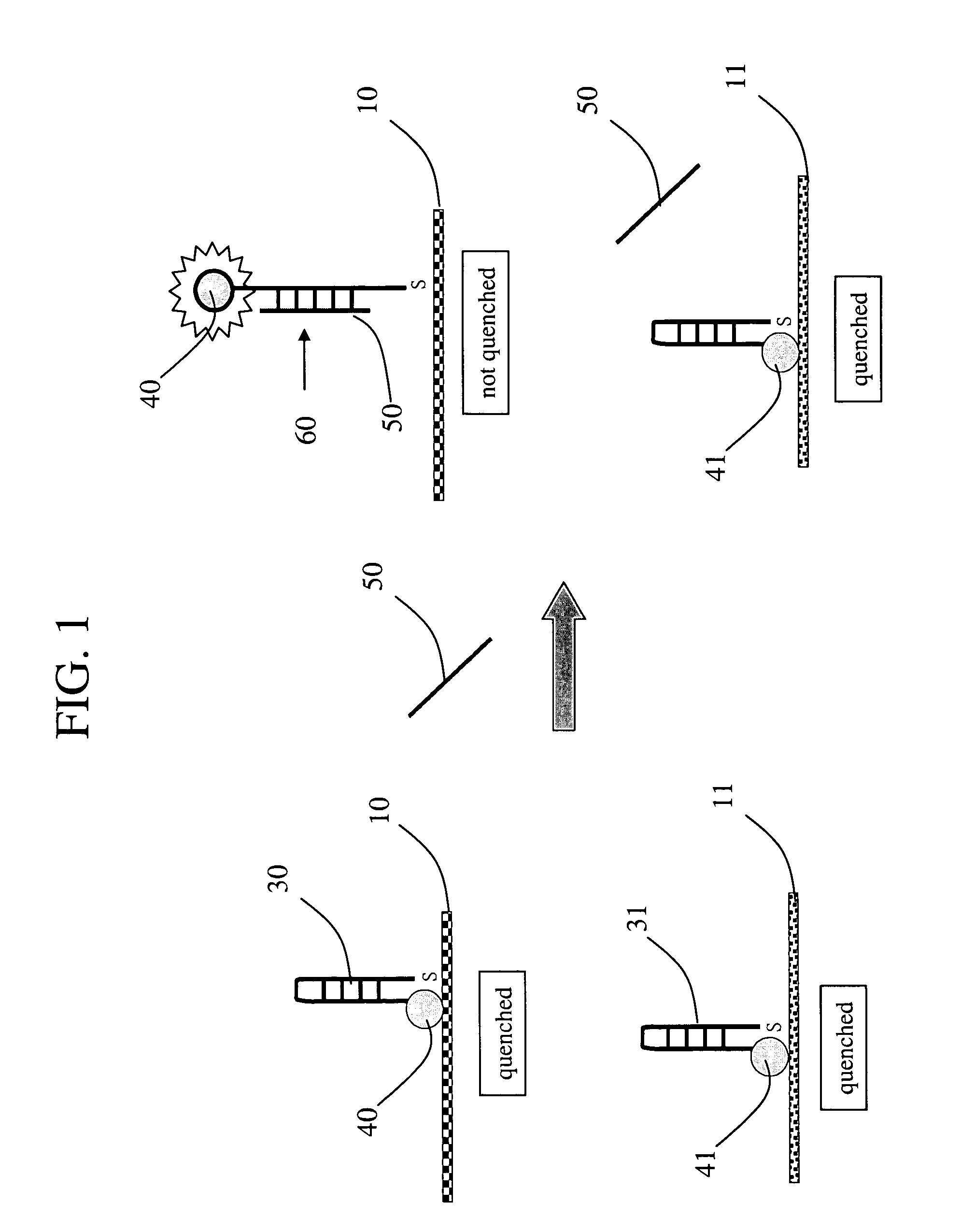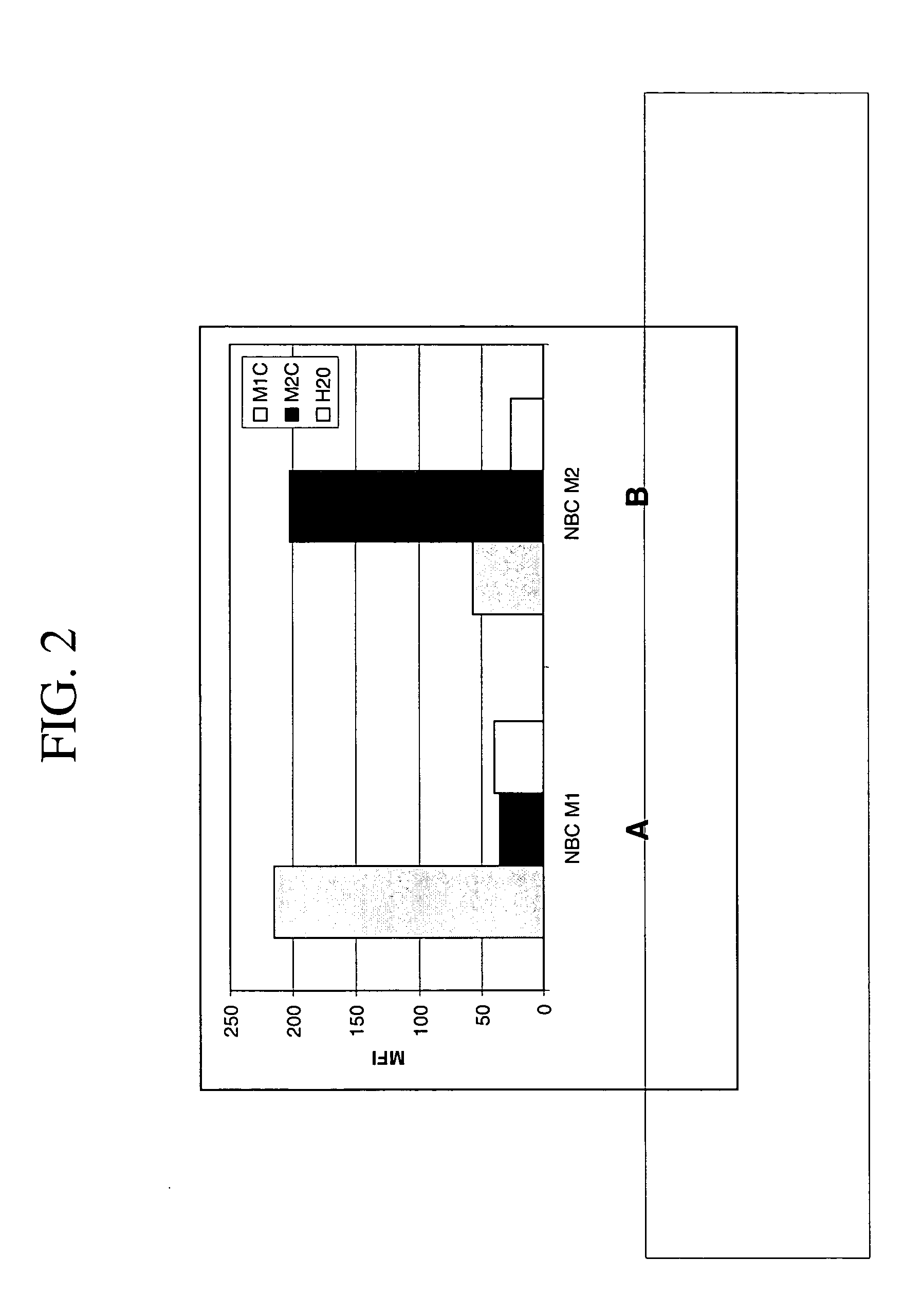Multiplexed molecular beacon assay for detection of human pathogens
a multi-molecular beacon and detection method technology, applied in the field of molecular biology, can solve the problems of fluorescence signal, high cost, complex biochemical background,
- Summary
- Abstract
- Description
- Claims
- Application Information
AI Technical Summary
Benefits of technology
Problems solved by technology
Method used
Image
Examples
example 2
[0074] Hybridization and Reading of Result. Combine 90 μl hybridization buffer (HS114, Molecular Research Center, Inc.), 10 μL of 10 μM target oligo, 3 μL NBC-probe. Shake at 42° C. for 1 hr. Wash once with 1×SSC and once with 0.1×SSC one time. Add 30 μL 5 mM PBS and image with microscopy.
example 3
[0075] Non-hairpin loop. A 32-mer oligonucleotide (M1) labeled with carboxytetramethylrhodamine (TAMRA) was conjugated to a Nanobarcodes particle (NBC). The resulting conjugated particle (NBC-M1) was incubated with a complementary sequence (M1C), a non-complementary sequence (M2C) and a water control. Upon hybridization with its complementary sequence (M1C), the fluorescence signal from the TAMRA label was over 200 MFI, compared to less than 50 MFI in the water and non-complementary controls. FIG. 4A. A similar experiment was carried out in which a different oligonucleotide (M2) labeled with TAMRA was conjugated to a NBC. The resulting conjugated particle (NBC-M2) was incubated with a complementary sequence (M2C), a non-complementary sequence (M1C), and a water control. Upon hybridization with its complementary sequence, the fluorescence signal from the TAMRA label was over 200 MFI compared to less than 50 MFI in the water and non-complementary controls. FIG. 4B. These results indic...
example 4
[0076] Multiplexed Assays
[0077] Nanobarcodes particles were conjugated with either TAMRA-labeled HIV probe oligonucleotide or TAMRA-labeled HCV oligonucleotide. As shown in FIG. 7, Nanobarcodes particles conjugated to TAMRA labeled HCV oligonucleotide probes were found to exhibit far greater fluorescence when contacted with complementary HCV target oligonucleotide compared to (noncomplementary) HIV target oligonucleotide or water. FIG. 7 (panel B). Similarly, Nanobarcodes particles conjugated to TAMRA labeled HIV oligonucleotide probes were found to exhibit greater fluoresce when contacted with complementary HIV target oligonucleotide compared to (noncomplementary) HBC oligonucleotide or water. FIG. 7 (panel A).
[0078] In another analysis, the probe sequences were linked to different types of encoded particles, as follows: The HIV probe sequence (HIV mb2) was conjugated to Nanobarcodes particles with code (00001); the HCV probe sequence (HCV mb2)was conjugated to Nanobarcodes parti...
PUM
| Property | Measurement | Unit |
|---|---|---|
| length | aaaaa | aaaaa |
| lengths | aaaaa | aaaaa |
| lengths | aaaaa | aaaaa |
Abstract
Description
Claims
Application Information
 Login to View More
Login to View More - R&D
- Intellectual Property
- Life Sciences
- Materials
- Tech Scout
- Unparalleled Data Quality
- Higher Quality Content
- 60% Fewer Hallucinations
Browse by: Latest US Patents, China's latest patents, Technical Efficacy Thesaurus, Application Domain, Technology Topic, Popular Technical Reports.
© 2025 PatSnap. All rights reserved.Legal|Privacy policy|Modern Slavery Act Transparency Statement|Sitemap|About US| Contact US: help@patsnap.com



